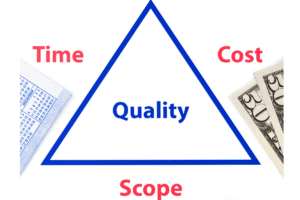Mastering Project Management: Navigating Projects with Finesse and Precision
Introduction to Project Management
The Art of Managing Project Endeavors with Finesse and Precision
Ah, project management – the art of orchestrating chaos, the essence of bringing order to the seemingly unruly. It is a field as old as human ambition itself, but one that has evolved into a refined discipline over time.
At its core, project management is about guiding and directing resources towards achieving specific goals within defined constraints. Whether you’re building a towering skyscraper or launching a marketing campaign, project management serves as the backbone that ensures success.
Defining Project Management: More Than Meets the Eye
Project management isn’t just about ticking tasks off a checklist or delegating work to eager individuals; it’s about meticulous planning, thoughtful coordination, and shrewd decision-making. By definition, project management encompasses the application of knowledge, skills, tools, and techniques to meet project objectives effectively and efficiently. It’s an ever-evolving field that combines artistry with science – one part precision engineering and another part strategic brilliance.
But why is project management so crucial in the grand scheme of things? Well, dear reader, let me enlighten you!
The Importance of Project Management: Navigating Choppy Waters with Grace
Imagine embarking on an ambitious journey without any semblance of direction or guidance – madness! Projects without proper management often turn into chaotic endeavors lost amidst an ocean of uncertainty. This is where project management swoops in like a valiant hero to save the day.
Effective project management brings structure to chaos by providing clarity in goals and expectations. It establishes well-defined roles and responsibilities for team members while promoting effective communication channels for seamless collaboration.
Through careful planning and monitoring of resources (time being one precious resource), projects can be completed on schedule while maintaining quality standards. Project management also acts as an essential compass, steering projects away from pitfalls and ensuring a smooth sail towards success.
It helps identify and mitigate risks, adapt to unforeseen circumstances, and maintain control over costs. By setting realistic targets and implementing efficient processes, project managers become the guiding lights that lead their teams towards triumphant victories.
Debunking Misconceptions: Project Management Unveiled
Now that we have established the significance of project management, it’s time to debunk some common misconceptions surrounding this captivating field. Firstly, project management is not just about rigidly adhering to plans at all costs.
Flexibility is key in navigating the ever-shifting tides of projects. Plans may change, unforeseen obstacles may emerge, and adjustments must be made accordingly.
Secondly, project management is not solely a top-down endeavor. While a capable project manager leads the charge, successful projects thrive on collaboration and teamwork.
Each team member contributes their unique skills and knowledge towards achieving collective success. Project management is not an isolated task performed in solitude.
It’s an interactive process that involves stakeholders at various levels. Effective communication with stakeholders helps manage expectations and ensures alignment with project goals.
With these misconceptions laid to rest like weary myths of yore, we can now delve deeper into the essential elements that compose the symphony of effective project management. So tighten your seatbelts as we embark on this enlightening journey together!
The Key Elements of Project Management
Project Initiation and Goal Setting
Every successful project starts with a clear understanding of its purpose and objectives. During the initiation phase, it is crucial to identify project stakeholders, those individuals or groups who have a vested interest in the project’s outcome.
Stakeholders can vary depending on the nature of the project, but commonly include clients, team members, executives, and end-users. Once you have identified the stakeholders, it’s time to define your project objectives and deliverables.
Objectives are what you aim to achieve through your project – they serve as overarching goals that guide your team’s efforts. Deliverables are tangible outcomes or results that need to be produced by the end of the project.
Project Planning and Scheduling
A well-structured plan is essential for project success. Creating a Work Breakdown Structure (WBS) is an effective way to break down complex projects into manageable tasks. By deconstructing your objectives into smaller components, you gain a clearer view of what needs to be done.
In addition to creating a WBS, estimating resources, time, and costs is crucial for effective planning. Resources include personnel, equipment, and materials required for the successful completion of each task.
Accurate time estimation allows you to determine realistic deadlines and allocate resources accordingly. Cost estimation helps you establish budgets and ensure financial feasibility throughout the project lifecycle.
Project Execution and Control
Once your plan is in motion, managing team dynamics and fostering effective communication becomes paramount. As a project manager, it is essential to understand individual strengths within your team and encourage collaboration among members.
Establishing open channels of communication ensures that everyone remains on track towards achieving their assigned tasks. To maintain control over your project, it is crucial to regularly monitor progress and adjust plans accordingly.
Actively tracking milestones and key performance indicators provides insights into whether your project is progressing as expected. If any deviations occur, swift action can be taken in the form of adjustments to resources, schedules, or even reevaluating objectives if necessary.
The Role of Stakeholder Management in Successful Projects
Identifying Project Stakeholders
In any project, stakeholder management plays a vital role in ensuring success. Identifying all relevant stakeholders at the beginning of your project helps you understand their interests, expectations, and potential impact on the project’s outcome. This identification process involves engaging with different individuals or groups who have a vested interest in your project’s success.
Stakeholders can be internal or external entities such as clients, end-users, team members, executives, suppliers, regulatory bodies – anyone who can influence or be affected by the project’s outcome. By recognizing these stakeholders early on, you can tailor your approach and communication strategies to address their specific needs and concerns.
Defining Project Objectives and Deliverables
Once you have identified your stakeholders’ interests and expectations, it becomes easier to define clear project objectives and deliverables that align with their requirements. Objectives serve as the guiding principles that steer your team towards achieving desired outcomes. These objectives should be specific, measurable, attainable, relevant, and time-bound (SMART).
Deliverables are tangible results or products that need to be delivered at each phase of the project. Clearly defining these deliverables ensures everyone involved understands what needs to be accomplished within each stage.
Essential Skills for Effective Project Managers
Leadership Skills: Inspiring and Motivating Team Members
In the realm of project management, effective leadership skills are paramount to driving a team towards success. A true leader possesses the ability to inspire and motivate team members, ensuring they remain focused and driven throughout the project lifecycle.
One crucial aspect of inspiring a team is setting clear goals and expectations. By establishing a compelling vision for the project, project managers can ignite a sense of purpose within their team members.
They should communicate these goals clearly, emphasizing how individual contributions contribute to the overarching objectives. Motivation is another key element in effective leadership.
Acknowledging the efforts and achievements of team members goes a long way in boosting morale and encouraging continued dedication. Recognizing their contributions publicly or privately can foster a positive work culture that nurtures growth and innovation.
Decision-Making Under Pressure
Project management often presents situations where tough decisions must be made under immense pressure. Effective project managers possess strong decision-making abilities even in high-stress scenarios. They analyze available information, weigh risks and benefits, consult with relevant stakeholders, and make well-informed choices that align with the project’s objectives.
To make sound decisions under pressure, project managers need to remain calm amidst chaos. Taking a step back to assess the situation objectively can help them see through the fog of urgency and identify potential solutions more effectively.
Technical Skills: Understanding Project Management Software Tools
In our increasingly digital world, understanding project management software tools is essential for efficient planning, coordination, and execution of projects. Project managers should familiarize themselves with popular software platforms like Microsoft Project or Basecamp as they offer powerful features for task management, resource allocation, timeline visualization, and collaboration.
By mastering these tools’ functionalities such as creating Gantt charts or setting dependencies between tasks, project managers can streamline project workflows, optimize resource allocation, and monitor progress in real-time. Being tech-savvy enables better communication and coordination with team members, leading to increased productivity and improved project outcomes.
Communication Skills: Effective Stakeholder Communication
Successful project managers recognize the significant role communication plays in driving projects towards success. They possess excellent verbal and written communication skills, allowing them to convey ideas clearly, concisely, and persuasively to stakeholders at all levels. Effective stakeholder communication involves not only transmitting information but also active listening.
Project managers should create an open environment that encourages stakeholders to voice their concerns, suggestions, or feedback. By actively listening to their perspectives and incorporating relevant insights into decision-making processes, project managers can foster stronger relationships with stakeholders while enhancing the overall project’s quality.
Active listening techniques such as paraphrasing or seeking clarification demonstrate genuine interest in understanding other’s viewpoints. These techniques help ensure that all stakeholders feel heard and valued throughout the project lifecycle, ultimately leading to smoother collaboration, minimized conflicts, and increased stakeholder satisfaction.
With these essential skills—inspiring leadership abilities, effective decision-making under pressure, technical proficiency with project management software tools, and strong communication skills—project managers can navigate challenges confidently while driving their teams towards successful outcomes. These skills form the foundation upon which effective project management is built—a harmonious blend of expertise that transforms projects from mere plans into remarkable achievements.
Project Risk Management: Mitigating the Unexpected
Identifying potential risks in projects
When embarking on a project, it is crucial to identify potential risks that could hinder its successful completion. These risks can be categorized into two main types: internal and external.
Internal risks encompass factors within the organization’s control, such as resource constraints. For instance, if a project lacks sufficient budget or manpower, it may face delays or compromised quality.
On the other hand, external risks are beyond the organization’s immediate control and often arise from external factors like market fluctuations. These fluctuations can impact the availability and cost of resources necessary for the project.
Risk assessment techniques
To effectively manage and mitigate project risks, various risk assessment techniques come into play. Two commonly used methods are probability-impact matrix analysis and SWOT analysis (Strengths, Weaknesses, Opportunities, Threats).
Probability-impact matrix analysis involves evaluating each identified risk based on its likelihood of occurrence and its potential consequences on the project’s objectives. This exercise helps prioritize high-risk areas that require immediate attention.
SWOT analysis involves assessing both internal (strengths and weaknesses) and external (opportunities and threats) factors related to the project. By comprehensively analyzing these aspects, project managers gain valuable insights into potential risks associated with their projects.
Risk response strategies
Once potential risks have been identified and assessed, it is imperative to develop appropriate risk response strategies. Four common strategies include avoidance, mitigation, transfer, and acceptance. Avoidance entails eliminating or minimizing a risk by altering plans or objectives to avoid possible negative impacts altogether.
Mitigation focuses on reducing the probability or impact of identified risks through proactive measures such as developing backup plans or implementing preventive actions. Risk transfer involves shifting the responsibility for managing specific risks to another party through contracts or insurance policies – in other words, sharing the burden.
Acceptance is a conscious decision to acknowledge the existence of certain risks and their potential consequences without taking any specific actions. This strategy is typically employed when the associated costs or efforts outweigh the potential benefits of further risk management.
Contingency planning for worst-case scenarios
While risk response strategies are crucial, it is equally important to prepare for worst-case scenarios through contingency planning. Contingency planning involves identifying specific actions or measures that can be taken if a high-impact risk materializes. These plans outline steps to be executed in case of emergencies or unforeseen circumstances that may jeopardize the project’s objectives.
Contingency plans often include alternative approaches, resource reallocation, or trigger points that indicate when specific actions should be implemented. By proactively creating contingency plans for potential worst-case scenarios, project managers can mitigate the negative impacts of unexpected events on their projects and maintain an efficient course towards successful completion.
Overall, effective project risk management requires a systematic approach encompassing risk identification, assessment, response strategies, and contingency planning. By being proactive in managing risks throughout the project lifecycle, organizations can increase their chances of delivering successful projects while minimizing delays and disruptions caused by unforeseen circumstances.
The Role of Stakeholder Management in Successful Projects
Identifying and Classifying Stakeholders
Stakeholders play a crucial role in the success of any project. They are individuals or groups who have a vested interest in the project and can influence its outcome.
Identifying stakeholders is the first step towards effective stakeholder management. It involves identifying all individuals, departments, organizations, or communities that can impact or be impacted by the project.
Once identified, stakeholders should be classified based on their level of influence and interest in the project. This classification helps prioritize communication efforts and tailor engagement strategies to ensure their needs are addressed.
Engaging Stakeholders with Open Communication
Effective stakeholder management relies on open and transparent communication channels. Engaging stakeholders throughout the project lifecycle builds trust and fosters collaboration.
Regular meetings, progress updates, and feedback sessions enable stakeholders to provide valuable insights, address concerns, and align expectations with project goals. By involving stakeholders early on, decision-making becomes more inclusive and consensus-driven.
Achieving Win-Win Outcomes through Conflict Resolution
Conflicts between stakeholders may arise due to different interests or priorities within a project. Skillful conflict resolution is essential for maintaining positive relationships among stakeholders while advancing towards project success.
Project managers should facilitate open dialogue between conflicting parties to understand each perspective fully. Through negotiation or compromise, win-win outcomes can be achieved by finding common ground that satisfies the needs of all parties involved.
Conclusion
Effective stakeholder management is integral to achieving successful outcomes in projects of all sizes and complexities. By identifying stakeholders early on and understanding their roles and interests, project managers can tailor their communication strategies accordingly.
Engaging stakeholders through open communication channels ensures that their voices are heard throughout the project lifecycle, increasing transparency and minimizing potential conflicts along the way. Ultimately, stakeholder management is about building relationships and finding common ground.
By fostering collaboration and addressing concerns proactively, project managers can create an environment that promotes trust, engagement, and shared ownership. When stakeholders feel valued and involved, they are more likely to support the project’s objectives, leading to a higher chance of success.
So remember, effective stakeholder management is not just a box to tick—it’s the key to unlocking the full potential of your projects. Embrace it, and watch your projects thrive!






